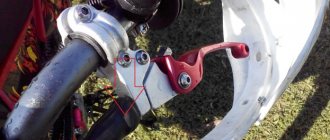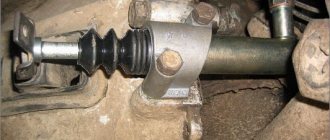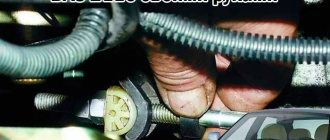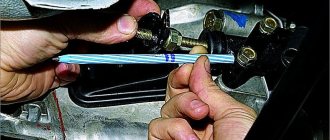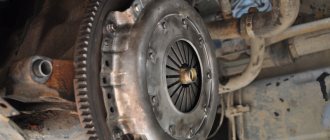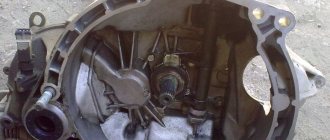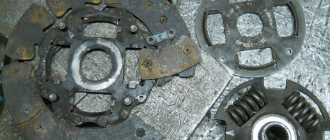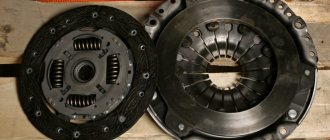Adjusting the clutch of the VAZ 2114 is one of the most important of the car. It allows you to achieve the most accurate operation of the system, which has a positive effect on the control process and driving comfort of the car. To implement this event, no in-depth knowledge, high qualifications or special professional tools are required. Any car enthusiast can handle this with the help of standard tools that come with the vehicle. In this article we will take a detailed look at clutch adjustment for one of the most popular car models, the “fourteenth”
When is clutch adjustment required?
VAZs use a dry type of clutch, that is, there is a basket consisting of two parts - driving and driven
Clutch adjustment of the VAZ 2114, and other vehicles, is carried out in cases where defects associated with the operation of this mechanism appear. Such malfunctions include:
- clutch pedal adjustment;
- clutch cable adjustment;
- pedal height adjustment;
- clutch adjustment.
In another case, the need to adjust the clutch drive may arise due to previous incorrect adjustment. It is possible to reduce or increase the working stroke of its pedal.
The photo shows the clutch of a VAZ 2114
As a result, malfunctions occur in the operation of the drive - the clutch begins to “slip” or “drive”, gear shifting becomes difficult, jerks appear when starting from a standstill, fuel consumption increases, etc.
Briefly about the design of a friction clutch and its purpose
Any self-respecting motorist will study the design of the unit before adjusting the clutch on a VAZ 2114. This will help you approach the issue wisely and avoid mistakes.
The mechanical drive design is simple and reliable. Compared to hydraulics, the cable requires minimal maintenance, and changing it is not labor-intensive. The mechanical drive consists of the following elements:
- Adjustable sheathed cable.
- Control pedal.
- Clutch release fork lever.
- Bracket for fastening the end of the cable sheath.
- Brake and clutch pedal bracket.
The mechanism serves to transmit force from the pedal to the release fork, which, in turn, removes the friction disc from the flywheel. Using a cable drive avoids major problems such as fluid leaks and periodic bleeding of air from the clutch control system. The weakest link in this chain is the cable, the quality of which at times leaves much to be desired. Therefore, replacing a cable on a Samara is a fairly common occurrence.
Meanwhile, the question of how to adjust the clutch on a VAZ 2114 car remains relevant for the cable mechanism. Setting standard values guarantees optimal tightness of the driven disk to the plane of the flywheel and basket when the clutch is engaged. The design also ensures complete separation (switching off) of the above parts from the passenger compartment through the pedal.
Checking the working stroke of the clutch pedal VAZ 2114
Let's measure the travel of the car's clutch pedal. Before doing this, we move the carpet on the floor of the car back so that the measurements are more accurate.
- Using a tape measure, measure the distance from the floor of the car to the bottom edge of the clutch pedal
- The image shows how best to do this.
- It should be approximately 18-20 cm.
- Press the clutch pedal all the way with your hand and measure the distance from the floor to the bottom edge of the pedal.
- It should be 6-7 cm
- Subtract from 18-20, 6-7, it turns out 13-14 cm
This is the norm for the full travel of the clutch pedal of VAZ 2108, 2109, 21099 cars and their modifications. Many repair manuals indicate a working stroke size of 12.5-13.5 cm, which is also very close to our measurement.
If the clutch pedal travel differs more or less, it is necessary to adjust the clutch drive.
Video “Setup Guide”
User Sergey Serge published a video that clearly demonstrated the procedure for changing the position of the pedal, indicating all the nuances of this task.
Do you have any questions? Specialists and readers of the AUTODVIG website will help you ask a question
Was this article helpful?
Thank you for your opinion!
The article was useful. Please share the information with your friends.
Yes (100.00%)
No
X
Please write what is wrong and leave recommendations on the article
Cancel reply
Rate this article: ( 7 votes, average: 4.57 out of 5)
Discuss the article:
Clutch pedal adjustment
Periodic adjustment of the VAZ 21014 clutch pedal is carried out for the following reasons:
- When driving on a non-adjustable clutch pedal, subsequent repairs are possible, because exaggerated energy costs for incorrect operation of the mechanism will cause malfunctions of other components of the car.
- Due to improper functioning, the clutch pedal periodically does not function. This leads to the fact that the pressure plate of the unit is forced into “engagement” with the motor flywheel, as a result of which they are subject to accelerated wear.
- If the pedal stroke is insufficient, the vehicle slips, i.e. the required torque of the wheel pair is lost.
To carry out diagnostic work on adjusting the clutch pedal, you need to use an arithmetic ruler to measure the length of the pedal stroke to the floor. If it does not correspond to 16 cm, then adjustments are necessary.
Signs of incorrect operation of the clutch mechanism: there is no possibility of a smooth start from a standstill, movement from a standstill is accompanied by jerks and jolts, when changing gears the transmission makes increased noise, the pedal of the mechanism falls to the lower position. In practice, it turns out this way: if the vehicle began to move from the moment the pedal began to be lowered, then the free play does not correspond to the required value. When the pedal is completely released, the vehicle does not move, which means there is no free movement in the car.
Clutch pedal adjustment:
- Unscrew the nut located under the clutch pedal.
- Tighten the locknut located below until it stops.
- Next, screw in the fasteners located under the clutch pedal.
- We tighten the rubber washer to the clutch fork as far as possible.
- To increase the pedal stroke, you need to screw the fastener onto the tip. To reduce the pedal stroke, you need to unscrew this fastener. The VAZ 2109 clutch pedal is adjusted until the limit of 12-13 cm is reached.
- After completing the pedal adjustment operations, you need to: depress the pedal three times, measure the length of the pedal stroke, adjust the operation until the required stroke length is achieved.
To adjust the hydraulics you need:
- Remove the spring from the mountings of the working cylinder and the clutch fork.
- Adjust the fasteners located on the clutch cylinder rod.
- The recommended free play value is 0.5 cm.
Often, a large pedal stroke depends on the height of its location from the driver's floor, and this creates certain difficulties. To adjust the height, a series of simple plumbing operations and a wrench set to “12” are required:
We find two fasteners on the steering column shaft, one is a thrust screw that limits the height adjustment position, the second is a lock nut that changes the movement of the pedal.
- Unscrew the stop screw.
- We give it rotation until the pedal movement normalizes.
- Screw in the locknut.
If slippage is observed after adjusting the clutch, then the following operations must be performed:
- Remove the stem locknut.
- Move it until there is no free movement.
- Return the rod one full turn.
- Determine whether the clutch has free play.
- Test the operation of the transmission gears. If there is an incomprehensible noise, you need to perform the above operations again.
- Screw in the locknut.
How to adjust the clutch cable
To properly tighten the cable, it is necessary to carry out this procedure.
- Drive the car onto a level surface and put the handbrake on.
- For safety's sake, disconnect the terminals from the battery.
- In the cabin, near the corresponding pedal, place a ruler parallel to its movement. Ideally, the lever pad should be within 13 cm. An error of up to 5 mm is allowed. In case of large deviation, adjustment is required.
The hood opens. There is an air filter near the battery. You can remove it by releasing the air duct clamp (with a screwdriver or a No. 8 socket). Under the dismantled can you need to find the clutch cable itself. The part is located near the gearbox housing. There is a tensioner lock on it (it looks like several nuts threaded onto the casing and pressing the mounting plate on both sides). Use wrench No. 17 to loosen the locknuts. If necessary, you can treat the mount with WD-40 or its equivalent. Then, using a 13mm horn, loosen the thrust nuts (1 and 2). Next, the tension of the shirt is adjusted. Nuts No. 1, 2 rotate counterclockwise. Thus, the pedal settles closer to the floor; to raise the lever, you need to do the opposite. After calibration, the mechanism is assembled in the reverse order. Next, you need to press the corresponding pedal 5-6 times all the way and repeat the procedure with the ruler. If there is no position failure, everything is fine.
Adjusting the clutch drive (cable) of the VAZ 2114
The clutch drive adjusting nut is located in the engine compartment of the car on the drive cable sheath, inserted into a special bracket mounted on the gearbox housing. It is protected from unscrewing by a lock nut located there.
Holding the adjusting nut with one 17 mm wrench, use another 17 mm wrench to loosen the lock nut a few turns.
Adjusting the clutch cable VAZ 2114
We rotate the adjusting nut clockwise with one key, holding the locknut with the other - this is to increase the clutch pedal travel (the pedal will rise) or counterclockwise to decrease its travel (the pedal will lower to the floor)
How much to reduce or, conversely, increase the pedal stroke is determined based on the results of the check described above.
Lightly tighten the locknut
Press the clutch pedal several times and check again
If the resulting figure does not fit within the norm, we carry out the adjustment again. And so on until we achieve the required result.
After completing the adjustment, tighten the locknut
When the clutch is properly adjusted, the clutch pedal should be approximately level with the brake pedal.
Symptoms of a problem
Over time, the element, like many others, wears out. Because of this, the following symptoms appear:
- Slipping. This happens due to wear of the clutch disc, it loses its properties and can no longer provide a reliable connection between the engine and gearbox. This is felt when you press the gas pedal, the speed begins to rise, but the car does not accelerate.
- The clutch drives. The opposite situation is the previous one, when the disc is not released, which is why the gearbox is not completely disconnected from the car’s engine. Switching the box is accompanied by sharp sounds. This happens due to overheating of the disk, which changes its shape, making it a figure eight.
- The free play of the clutch pedal has increased. This happens due to the stretching of the cable. During operation, it begins to stretch, so the mechanism may also not fully unclench.
In all cases, you can try to eliminate the malfunction by adjusting the clutch.
Adjusting the VAZ 2109 clutch
Tightening the VAZ 2114 clutch
This operation is carried out in cases where there are shocks or friction when the clutch is engaged, slight slipping of the clutch when the clutch is pressed for a long time, the clutch “drives”.
To adjust the clutch, do the following:
- Place the gearshift lever in the “neutral” position.
- We dismantle the clutch housing.
- We dismantle the bearing. Repair operations should be carried out smoothly and calmly, because the bearing may be defective.
- Rotate the adjusting fastener until the pedal movement is completely adjusted.
- We test the clutch for oil leaks, otherwise the clutch mechanism may slip. To eliminate this problem, it is necessary to treat the coupling with a degreasing compound.
How to adjust?
An out-of-control drive is located several centimeters higher or lower relative to the brake. This makes the drive inconvenient to use and can cause accidents.
The drive position changes as a result of wear on the driven disk linings during prolonged driving of the vehicle. For VAZ 2115 cars, pedal travel is considered normal to be 125-135 mm. The maximum safe stroke does not exceed 160 mm. Adjustment is also necessary if the unit does not turn off completely or is slipping. Debugging is carried out by changing the length of the clutch cable and its sheath.
Tools
2 keys for 17. On the VAZ 2115, the lower end of the cable “jacket” is held on by two fasteners, which are loosened using these keys.
17 keys - the main tools for adjusting the clutch cable
Step-by-step instruction
Initially, it is worth measuring the pedal deviation from the norm. To do this, you need to push the drive to the maximum, then release it. It is necessary to measure the stroke length - the distance from the center of the pedal pad in its lower position, when it is resting on the floor, and in its upper position. If the deviation from the normal length is significant, the pedal should be adjusted. Deviations from the norm can be detected without measurements. To do this, you need to place the car on a flat horizontal surface, engage first gear and, smoothly releasing the drive, start moving. If the car starts moving only at the end of pressing the pedal, debugging is necessary. In order to adjust the drive of the VAZ 2115, it is necessary to change the length of the cable jacket. To do this, you need to loosen or tighten the two nuts with which it is attached to the bracket. Open the hood. Remove the air filter. We find the cable and nuts that secure it to the bracket. They are located on its threaded part. Unfortunately, on the VAZ 2115 these parts are located inconveniently. When manipulating the nuts, the length of the cable jacket changes. In order to reduce the stroke, loosen the nut located inside the bracket and tighten the nut outside, and vice versa, if you need to increase
It is important to remember that constriction, as well as weak tension, are unacceptable. When overtightened, the cable will quickly break, and if the tension is weak, the clutch will no longer disengage completely. If the threads are rusty, you can use liquid to make the threads easier to remove.
If there is none, you can use engine oil or brake fluid. After debugging, you should check changes in the operation of the node. This should be done in the same way as during the initial check for deviation from the norm. After correct adjustment, the stroke does not exceed 135 mm. If the procedure does not lead to anything and the clutch of your VAZ 2115 continues to slip, then the element has become unusable and needs to be replaced.
Structure and functions of clutch
The mechanical drive of the VAZ 2114, when compared with hydraulics, has a much simpler, but equally durable design. It consists of:
- cable, adjustable in length in the sheath;
Cable location
- pedals that control the clutch from the passenger compartment;
- a device that controls the position and free play of the pedal;
- lever structure that transmits force from the pedal to the clutch fork.
The introduction of a cable into the design of the VAZ 2114 made it possible to eliminate complications with hydraulics, for example, very frequent leakage of fluid.
Replacing the clutch mechanism
A complete replacement of the mechanism is required only if the friction device is critically worn or seriously damaged.
To remove the clutch you will need:
- drive the car onto a lift or inspection hole;
- remove the front left wheel, air filter and battery;
- unscrew the wires and cables coming from the gearbox;
- remove the gearbox and engine mount;
- next you will need to unscrew all visible bolts holding the box in place;
- carefully pulling out the gearbox, remove it and place it on previously prepared boards;
- On the dismantled unit, unscrew the clutch basket and all additional parts.
The new basket should be installed with a special guide, which will allow it to be secured evenly.
Examination
Having achieved the parameters established by the manufacturer of the VAZ 2114 car, after tightening the locknut, you need to make sure that you have adjusted the clutches correctly. To do this, you need to press the pedal to the floor 2-3 times and measure its travel again. If there are changes in its progress, the adjustment procedure must be repeated again. Usually the clutch begins to “grab” approximately in the middle of the stroke.
After completing the adjustment, it is necessary to perform one last check:
- park the car on a level area,
- tighten the parking brake lever,
- start the engine and engage the gear,
- Next, you need to try to move, without pressing the clutch.
